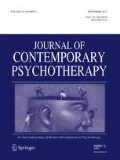Abstract
This article aims to explore the perception of body in hypochondriasis and implications that it has for fear of death and for treatment of hypochondriasis. It is suggested that a sense of threat posed by the body in hypochondriasis is intimately related to the fear of body, expectations of bodily failure, fear of disease and pathological fear of death. Clinical aspects and potential antecedents of these phenomena are discussed in the article. It is emphasized that fear of the body and fear of death should be adequately addressed in the course of treatment, regardless of the nature of the primary treatment approach. Relevant treatment strategies are outlined, with treatment goals including an adoption of the non-threatening perception of one’s body, modification of attitudes and beliefs related to health, illness and death which heighten fear of death, and substantial alleviation or elimination of the pathological fear of death.
Similar content being viewed by others
References
Baker, B., & Merskey, H. (1982). Parental representations of hypochondriacal patients from a psychiatric hospital. British Journal of Psychiatry, 141, 233–238.
Barsky, A. J., Ahern, D. K., Bailey, E. D., Saintfort, R., Liu, E. B., & Peekna, H. M. (2001). Hypochondriacal patients’ appraisal of health and physical risks. American Journal of Psychiatry, 158, 783–787.
Barsky, A. J., Coeytaux, R. R., Sarnie, M. K., & Cleary, P. D. (1993). Hypochondriacal patients’ beliefs about good health. American Journal of Psychiatry, 150, 1085–1089.
Barsky, A. J., Wool, C., Barnett, M. C., & Cleary, P. D. (1994). Histories of childhood trauma in adult hypochondriacal patients. American Journal of Psychiatry, 151, 397–401.
Bianchi, G. N. (1971). Origins of disease phobia. Australian and New Zealand Journal of Psychiatry, 5, 241–257.
Bridges, K., Goldberg, D., Evans, B., & Sharpe, T. (1991). Determinants of somatization in primary care. Psychological Medicine, 21, 473–483.
Craig, T. K., Boardman, A. P., Mills, K., Daly-Jones, O., & Drake, H. (1993). The South London Somatisation Study. I: Longitudinal course and the influence of early life experiences. British Journal of Psychiatry, 163, 579–588.
de Botton, A. (2000). The consolations of philosophy. Harmondsworth, UK: Penguin.
Hotopf, M., Mayou, R., Wadsworth, M., & Wessely, S. (1999). Childhood risk factors for adults with medically unexplained symptoms: Results from a national birth cohort study. American Journal of Psychiatry, 156, 1796–1800.
Kellner, R., Abbott, P., Winslow, W. W., & Pathak, D. (1987). Fears, beliefs, and attitudes in DSM-III hypochondriasis. Journal of Nervous and Mental Disease, 175, 20–25.
Mabe, P. A., Hobson, D. P., Jones, L. R., & Jarvis, R. G. (1988). Hypochondriacal traits in medical inpatients. General Hospital Psychiatry, 10, 236–244.
MacLeod, A. K., Haynes, C., & Sensky, T. (1998). Attributions about common bodily sensations: Their associations with hypochondriasis and anxiety. Psychological Medicine, 28, 225–228.
Marcus, D. K., & Church, S. E. (2003). Are dysfunctional beliefs about illness unique to hypochondriasis? Journal of Psychosomatic Research, 54, 543–547.
Noyes, R., Jr. (1999). The relationship of hypochondriasis to anxiety disorders. General Hospital Psychiatry, 21, 8–17.
Noyes, R., Jr., Stuart, S., Langbehn, D. R., Happel, R. L., Longley, S. L., & Yagla, S. J. (2002a). Childhood antecedents of hypochondriasis. Psychosomatics, 43, 282–289.
Noyes, R., Jr., Stuart, S., Longley, S. L., Langbehn, D. R., & Happel, R. L. (2002b). Hypochondriasis and fear of death. Journal of Nervous and Mental Disease, 190, 503–509.
Parker, G., & Lipscombe, P. (1980). The relevance of early parental experiences to adult dependency, hypochondriasis and utilization of primary physicians. British Journal of Medical Psychology, 53, 355–363.
Salkovskis, P. M., & Clark, D. M. (1993). Panic disorder and hypochondriasis. Advances in Behaviour Research and Therapy, 15, 23–48.
Schäfer, M. L. (1982). Phenomenology and hypochondria. In A. J. J., de Koning & F. A., Jenner (Eds.), Phenomenology and psychiatry (pp. 217–244). New York: Grune and Stratton.
Seneca. Dialogues and letters. Translated by C. D. N. Costa. London: Penguin, 1997.
Slavney, P. R. (1987). The hypochondriacal patient and Murphy’s “law.” General Hospital Psychiatry, 9, 302–303.
Starcevic, V. (1989). Pathological fear of death, panic attacks, and hypochondriasis. American Journal of Psychoanalysis, 49, 347–361.
Starcevic, V. (1990). Relationship between hypochondriasis and obsessive-compulsive personality disorder: Close relatives separated by nosological schemes? American Journal of Psychotherapy, 44, 340–347.
Stolorow, R. D. (1979). Defensive and arrested developmental aspects of death anxiety, hypochondriasis and depersonalization. International Journal of Psycho-Analysis, 60, 201–213.
Wahl, C. W. (1963). Unconscious factors in the psychodynamics of the hypochondriacal patient. Psychosomatics, 4, 9–14.
Wells, A. (1997). Cognitive therapy of anxiety disorders: A practice manual and conceptual guide. Chichester, UK: Wiley.
Wells, A., & Hackmann, A. (1993). Imagery and core beliefs in health anxiety: Contents and origins. Behavioural and Cognitive Psychotherapy, 21, 265–273.
Author information
Authors and Affiliations
Corresponding author
Rights and permissions
About this article
Cite this article
Starcevic, V. Fear of Death in Hypochondriasis: Bodily Threat and Its Treatment Implications. J Contemp Psychother 35, 227–237 (2005). https://doi.org/10.1007/s10879-005-4317-0
Issue Date:
DOI: https://doi.org/10.1007/s10879-005-4317-0



